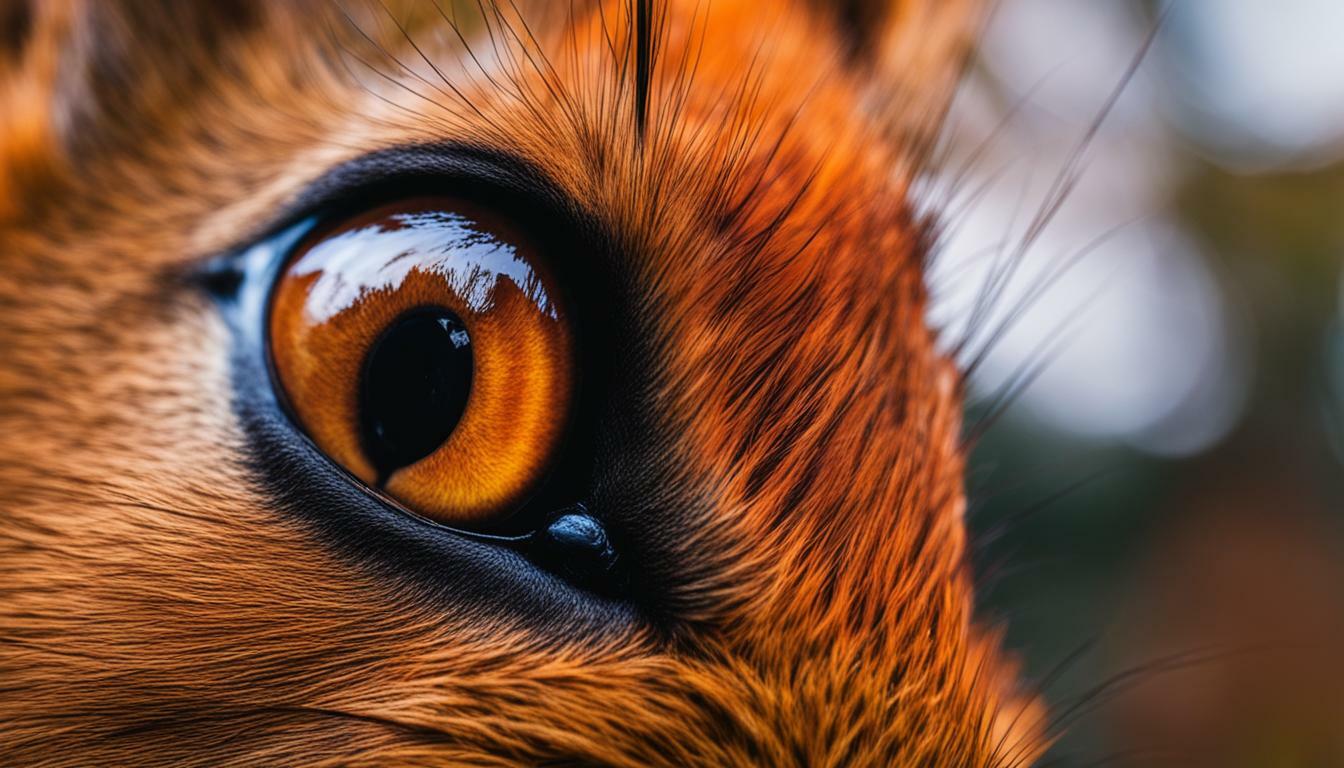Have you ever wondered if squirrels can see the color orange? These furry little creatures have remarkable visual abilities that allow them to navigate their environment with ease. In this article, we will delve into the world of squirrel eyesight and explore their perception of color.
Key Takeaways:
- Squirrels have dichromatic color vision, allowing them to see in color.
- While squirrels may perceive hunter orange as a light color rather than a fluorescent glow, wearing hunter orange is crucial for safety during hunting.
- Squirrels are more likely to notice the movement of a hunter wearing solid, unbroken color than the color itself.
- Camouflage clothing can help break up a hunter’s body outline and reduce the detection of movement, but it is not essential for squirrel hunting.
- The requirement to wear hunter orange for squirrel hunting varies from state to state.
Understanding Squirrel Vision
To understand if squirrels can see orange, let’s delve into their visual capabilities. Squirrels have dichromatic color vision, meaning they can see in color, although their color perception differs from humans. This variation in color perception is due to the number of cones in their eyes, which are responsible for distinguishing colors.
While humans have three types of cones that enable us to perceive a broad spectrum of colors, squirrels only have two types of cones. This limits their ability to differentiate between certain hues and shades. However, they can still perceive colors within the range of their vision, including orange.
When it comes to hunting, wearing hunter orange is often recommended for safety reasons. Although squirrels may not see hunter orange as a fluorescent glow, they can still perceive it as a light color. This is why it is essential for hunters to wear solid, unbroken colors to reduce the chances of being detected by squirrels.
Squirrel Vision and Camouflage
While hunter orange is important for safety, camouflage clothing can also play a role in squirrel hunting. Camouflage helps break up a hunter’s body outline and reduces the detection of movement by squirrels. By blending into their surroundings, hunters can increase their chances of remaining undetected and improving their hunting success.
| Hunter Orange | Camouflage Clothing |
|---|---|
| Increases safety | Reduces detection of movement |
| Visible as a light color | Blends into surroundings |
| Recommended but not essential | Can improve hunting success |
However, it’s important to note that camouflage clothing is not essential for squirrel hunting, and many hunters have been successful without it. The decision to use camouflage or stick to solid colors ultimately depends on personal preference and hunting conditions.
Variations in State Regulations
When venturing out for squirrel hunting, it’s crucial to be aware of the varying state regulations regarding the wearing of hunter orange. Some states may require hunters to wear hunter orange, while others may have no such requirements. It’s always advisable to check the specific regulations of the state where you plan to hunt to ensure compliance and safety during your hunting experience.
Can Squirrels See in Color?
Yes, squirrels can see in color, but their color perception differs from that of humans. While humans have trichromatic color vision, which allows us to see a wide range of colors, squirrels have dichromatic color vision. This means that their eyes contain two types of color-sensitive cells, or cones, instead of three like ours. As a result, their ability to perceive colors is limited compared to humans.
Squirrels primarily rely on their color vision for survival, particularly in finding food and detecting potential threats in their environment. They are most sensitive to shades of yellow and blue, which are the colors that stand out the most to them. Reds and oranges, including hunter orange, may appear less vibrant to squirrels, often appearing as light colors rather than the fluorescent glow that humans perceive.
While wearing hunter orange may not be as visually striking to squirrels as it is to humans, it is still necessary for safety purposes during hunting. The bright color helps human hunters stand out in the natural surroundings, ensuring that they are easily seen and identified by other hunters. This helps prevent accidents and promotes a safe hunting experience.
| Color Perception | Squirrels | Humans |
|---|---|---|
| Types of Cones | 2 (dichromatic) | 3 (trichromatic) |
| Colors Perceived | Primarily yellow and blue | Wide range of colors |
| Perception of Orange | Appears as a light color | Perceived as a vibrant color |
When it comes to hunting squirrels, the movement of the hunter is often more noticeable to the squirrels than the specific color of their clothing. Solid, unbroken colors are more likely to catch a squirrel’s attention, so wearing hunter orange can still be advantageous. However, camouflage clothing can help break up the hunter’s body outline, making it harder for squirrels to detect movement. While not essential for squirrel hunting, camouflage can offer an additional advantage for stealthy approaches.
It is important to note that state regulations regarding the requirement to wear hunter orange during squirrel hunting may vary. Make sure to check the specific regulations in your state to ensure compliance with the law and promote a safe hunting experience.
Squirrel Color Vision
Squirrels have dichromatic color vision, meaning they can perceive certain colors but not as many as humans. While humans have trichromatic color vision, allowing them to see a wide spectrum of colors, squirrels have only two types of color receptors in their eyes. This limits their color perception to shades of blue and green.
Despite their limited color vision, squirrels rely on other visual cues to navigate their environment and identify food sources. They have excellent motion detection abilities and can easily spot any movement in their surroundings. This makes it important for hunters to consider their movements and minimize any sudden or jerky actions while squirrel hunting.
When it comes to hunting gear, wearing hunter orange is crucial for safety. Although squirrels may not perceive the color as vividly as humans, they can still see hunter orange as a light color. This helps to distinguish hunters from their surroundings and prevents accidental shootings. Therefore, it is essential to comply with state regulations regarding hunter orange requirements during squirrel hunting.
| Hunter Clothing | Effectiveness in Squirrel Hunting |
|---|---|
| Camouflage Clothing | Helps break up a hunter’s body outline and reduces the detection of movement. |
| Solid Color Clothing | More likely to be noticed by squirrels due to the unbroken color. |
While wearing camouflage clothing can aid in concealing a hunter’s presence in the forest, it is not essential for squirrel hunting. Many hunters have had successful hunts without the use of camouflage clothing. However, for those who choose to use it, it is important to remember that movement, rather than color, is the primary factor that squirrels notice.
In conclusion, squirrels have dichromatic color vision, perceiving only a limited range of colors. While they may not perceive hunter orange as fluorescently bright, wearing it is necessary for safety during squirrel hunting. Camouflage clothing can help break up a hunter’s body outline and reduce the detection of movement but is not essential. Remember to comply with state regulations regarding hunter orange requirements, as these may vary from one state to another.
The Perception of Orange
When it comes to the color orange, squirrels may perceive it differently than humans do. These furry creatures have dichromatic color vision, meaning they can see in color, but their range of color perception is limited compared to ours. While humans have trichromatic color vision, allowing us to see a wide spectrum of colors, squirrels rely on just two types of cones in their eyes to detect color: blue and green.
For squirrels, orange may appear as a light color rather than the vibrant hue we see. This can be attributed to the fact that they have a reduced sensitivity to red and orange wavelengths. So while a bright orange object may catch our attention, it might not stand out as much to a squirrel.
Despite this difference in perception, wearing hunter orange is still crucial for safety during squirrel hunting. Although squirrels may not see the color as fluorescent or highly noticeable, the movement of a hunter wearing solid, unbroken color is more likely to catch their attention. By wearing hunter orange, hunters can make themselves more visible and reduce the risk of accidents in the field.
Why Hunter Orange Matters
Camouflage clothing has long been associated with hunting, but it is not essential for squirrel hunting. Squirrels are more likely to notice the movement of a hunter rather than the specific color they are wearing. However, wearing hunter orange can still serve as an added safety measure.
Hunter orange helps break up the hunter’s body outline and makes it easier for other hunters to recognize their presence in the woods. This can prevent accidental shootings and promotes a safer hunting environment. While it might not be as effective as camouflage in terms of blending into the surroundings, the visibility it provides outweighs its potential drawbacks.
It is important to note that the requirement to wear hunter orange during squirrel hunting varies from state to state. Some states have specific regulations mandating the use of hunter orange, while others may leave it up to the discretion of the individual hunter. Before heading out for a squirrel hunt, it is crucial to familiarize yourself with the hunting regulations in your particular state to ensure compliance and safety.
Hunter Orange and Squirrel Hunting
Wearing hunter orange is important for safety during hunting, but its visibility to squirrels may differ. Squirrels have dichromatic color vision, meaning they can see in color, but their perception of certain colors may not be the same as that of humans. Instead of perceiving hunter orange as the bright fluorescent color we see, squirrels may interpret it as a lighter color.
While squirrels may not be able to see the exact color of hunter orange, it is still crucial for hunters to wear this color for their own safety and to prevent accidents. Squirrels are more likely to notice the movement of a hunter rather than the color itself. Wearing solid, unbroken colors, such as hunter orange, helps break up a hunter’s outline and can make them less visible to squirrels.
Many hunters choose to wear camouflage clothing during squirrel hunting to further reduce the chances of being detected by squirrels. Camouflage can help blend a hunter’s silhouette with the surrounding environment, making it harder for squirrels to detect any movement. However, it’s important to note that wearing camouflage is not essential for squirrel hunting, and many hunters have been successful without it.
Hunter Orange Requirements by State
The regulations regarding the use of hunter orange during squirrel hunting vary from state to state. Some states may require hunters to wear a minimum amount of hunter orange, such as a hat or vest, while others may have more specific requirements. It’s crucial for hunters to familiarize themselves with the regulations of their respective states to ensure they comply with the necessary safety precautions.
| State | Hunter Orange Requirement |
|---|---|
| Texas | At least 400 square inches of hunter orange visible above the waist |
| Michigan | A hat or an outer garment above the waist must be hunter orange |
| Minnesota | Hunters must have at least one article of hunter orange clothing visible above the waist |
| Wisconsin | Hunters are required to wear at least 50% hunter orange above the waist, including a hat |
Always remember to check the specific regulations of your state before heading out for squirrel hunting. Staying informed and following the rules ensures a safe and enjoyable hunting experience for everyone involved.
Camouflage and Squirrel Hunting
Camouflage clothing can help reduce the detection of movement by squirrels during hunting. Squirrels have exceptional eyesight and can quickly spot any sudden movement or unfamiliar shapes in their environment. By wearing camouflage clothing that blends in with the natural surroundings, hunters can effectively break up their body outline and make it more difficult for squirrels to detect their presence.
When choosing camouflage clothing for squirrel hunting, it’s important to consider the specific environment you’ll be hunting in. Opt for patterns that mimic the colors and textures of the area, whether it’s a dense forest, a woodland meadow, or a brushy terrain. This will help you blend seamlessly into your surroundings and make it harder for squirrels to spot you.
In addition to camouflage clothing, hunters should also pay attention to their movement. Squirrels are more likely to notice sudden motions rather than specific colors. Moving slowly and deliberately can help minimize any unnecessary disturbance and increase your chances of a successful hunt.
| Key Points: | Squirrel Vision and Camouflage |
|---|---|
| 1. | Squirrels have excellent eyesight and can detect movement easily. |
| 2. | Camouflage clothing can help break up your body outline and make it harder for squirrels to spot you. |
| 3. | Choose camouflage patterns that match the environment you’ll be hunting in. |
| 4. | Move slowly and deliberately to minimize disturbance and increase your chances of a successful hunt. |
It’s important to note that while camouflage clothing can be beneficial in squirrel hunting, it’s not essential for success. Many hunters have been able to effectively hunt squirrels without the use of camouflage. Ultimately, the key to a successful hunt lies in patience, skill, and understanding squirrel behavior.
It’s worth noting that the requirement to wear hunter orange during squirrel hunting varies from state to state. Hunter orange is a highly visible color that helps distinguish hunters from game animals, ensuring safety and reducing the risk of accidents. While squirrels may perceive hunter orange as a light color rather than a bright fluorescent glow, it is still necessary to wear it for your own safety and the safety of others in the vicinity.
State Regulations and Hunter Orange
The rules regarding the use of hunter orange during squirrel hunting vary from state to state. It is important for hunters to familiarize themselves with the specific regulations in their area to ensure compliance and promote safety in the field. While some states require hunters to wear hunter orange as a mandatory precaution, others may have more lenient guidelines.
For example, in some states, such as New York and Pennsylvania, hunters are required to wear a minimum amount of hunter orange clothing during specific hunting seasons. This typically includes a hunter orange hat and/or vest. The purpose of these regulations is to enhance visibility and minimize the risk of accidental shootings, as hunter orange is highly visible to other hunters in the field.
On the other hand, certain states may have more relaxed regulations when it comes to wearing hunter orange during squirrel hunting. Although not mandatory, it is still recommended to wear hunter orange for safety purposes. Even though squirrels may not perceive hunter orange as a fluorescent glow, it can still help distinguish hunters from wildlife and reduce the chances of mistaken identity.
| State | Hunter Orange Requirement |
|---|---|
| New York | Required during certain hunting seasons |
| Pennsylvania | Required during certain hunting seasons |
| Michigan | Not required, but recommended |
Ultimately, the decision to wear hunter orange during squirrel hunting should prioritize safety. While squirrels are more likely to notice the movement of a hunter rather than the color itself, wearing solid, unbroken colors and hunter orange can help reduce the chances of accidental incidents. It is always best to check the specific regulations in your state and take appropriate precautions to ensure a safe and responsible hunting experience.
Conclusion
In conclusion, while squirrels can see in color, their perception of the color orange may differ from humans. Squirrels have dichromatic color vision, meaning they possess two types of color receptors in their eyes. This allows them to perceive a limited range of colors compared to humans who have trichromatic color vision with three types of color receptors.
When it comes to hunter orange, squirrels may not perceive it as a fluorescent glow but rather as a light color. Despite this, it is essential for hunters to wear hunter orange during squirrel hunting for safety reasons. The bright color helps hunters stand out and prevents accidents in the field, ensuring that other hunters can easily identify their presence.
Interestingly, squirrels are more attuned to detecting movement rather than specific colors. Wearing solid, unbroken color clothing helps reduce the chances of squirrels noticing the hunter’s movement. Camouflage clothing, although not necessary, can further aid in breaking up the hunter’s body outline and decreasing the likelihood of detection by squirrels.
However, it’s worth noting that the requirements for wearing hunter orange during squirrel hunting can vary from state to state. It is crucial for hunters to familiarize themselves with the specific regulations in their state to ensure compliance and safety while enjoying this popular outdoor activity.
FAQ
Can squirrels see the color orange?
Yes, squirrels have dichromatic color vision and can perceive the color orange. However, they may see it as a light color rather than a fluorescent glow.
Do squirrels see in color?
Yes, squirrels have the ability to see in color. They have dichromatic color vision, meaning they can perceive certain colors.
How do squirrels perceive the color orange?
Squirrels perceive the color orange as a light color rather than a fluorescent glow. Their color vision allows them to see the color, but the perception may differ from humans.
Is wearing hunter orange necessary for squirrel hunting?
Wearing hunter orange is necessary for safety and to avoid accidents while hunting. Although squirrels may perceive the color as a light shade, solid, unbroken colors are more likely to attract their attention.
Does camouflage clothing help in squirrel hunting?
Camouflage clothing can help break up a hunter’s body outline and reduce the detection of movement by squirrels. While not essential, it can be beneficial in increasing hunting success.
Are there state regulations regarding wearing hunter orange for squirrel hunting?
Yes, the requirement to wear hunter orange during squirrel hunting varies from state to state. It is important to be aware of and follow the specific regulations in your state.




